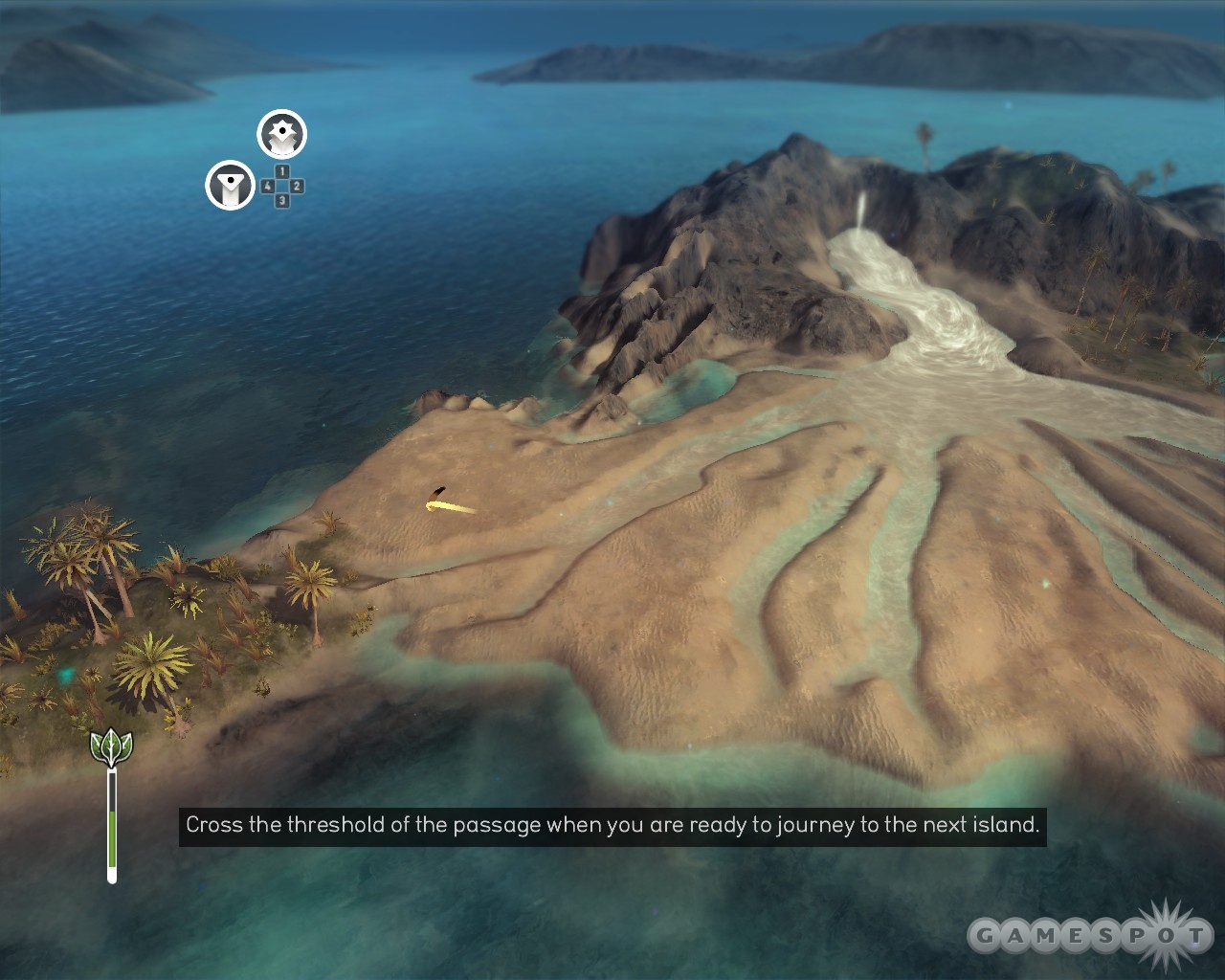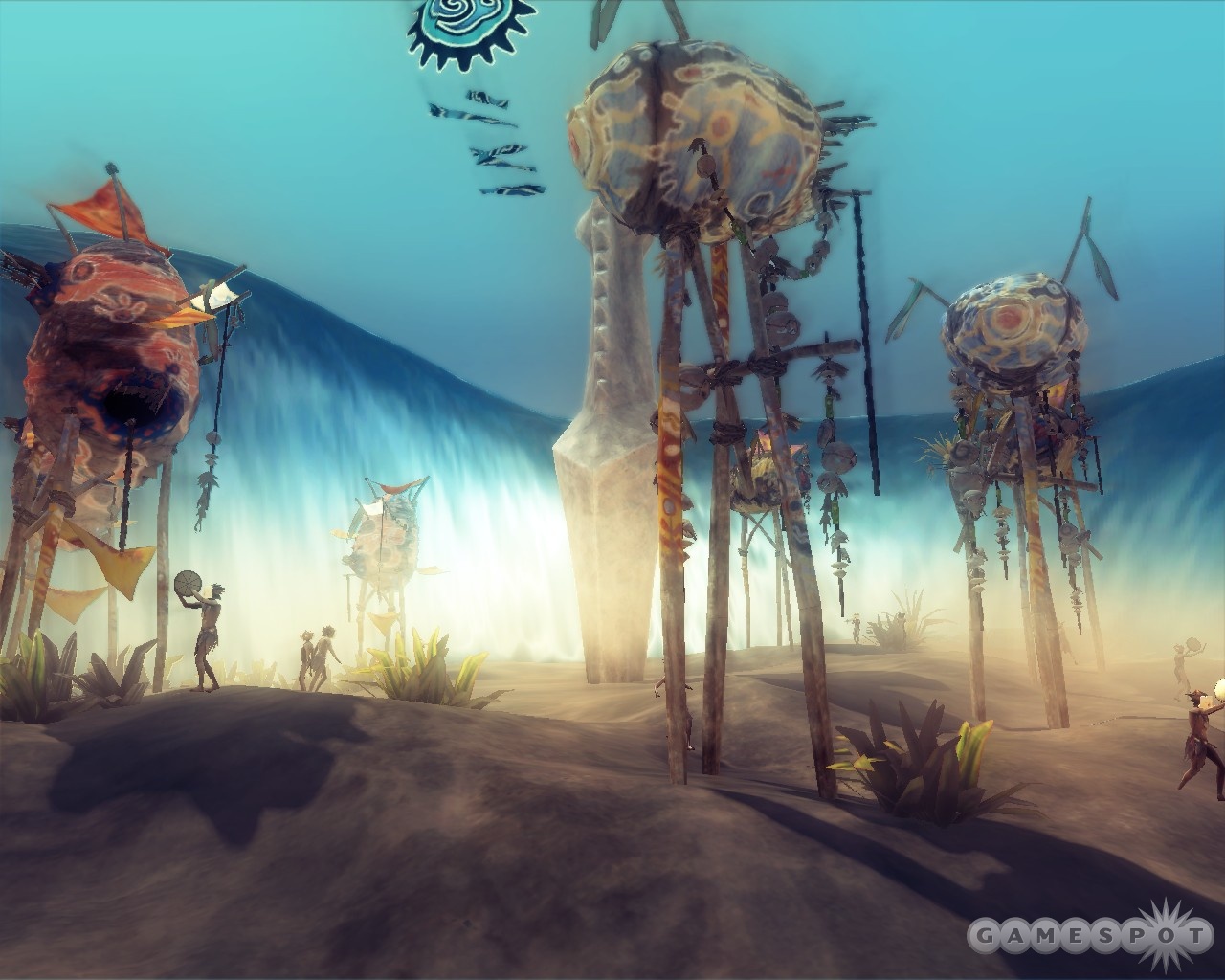What if you had the powers of a god? The earth would shift at your whim and the seas would tremble at your touch. You could raise mountains, divert rivers, and transform dry deserts into lush forests. From Dust grants you these powers and more, and it's satisfying to wield them as you try to safely usher a small tribe of humans through a perilous world. Yet, for all your world-molding abilities, you are not omnipotent. Like the villagers you shelter, you must contend with the inexorable power of nature. From the subtle influence of gravity and erosion to the devastating forces of volcanoes and tsunamis, nature compels you to adapt to survive. This task can get difficult, especially when imperfect controls, finicky pathfinding, and unforeseeable disasters conspire against you. Joining these in-game problems are a number of PC-specific shortcomings, including limited visual options and an Internet connectivity requirement. Despite these unwelcome elements, the challenge of being a lesser god is an engaging one, and From Dust makes it even more enticing with appealing visuals and evocative music.
Before you begin to bend nature to your will, you must first secure an Internet connection. This is not only necessary to download the game from Steam, but also required each and every time you play the game. From Dust syncs with Ubisoft's uPlay service and won't launch if you can't connect. Once you are connected, it's best to let the game load to the menu screen before trying to use any in-game Steam functions because any activity may cause the game to freeze or prevent the menu from loading properly. Alt-tabbing out of the game also caused a visual glitch when we resumed playing. And speaking of visuals, don't expect a full suite of options to help you maximize performance; screen resolution, display mode, refresh rate, and adapter version are all you get. These issues don't spoil the experience, but they do make it feel like you aren't playing the best version. The PC version does boast sharper visuals than its Xbox 360 counterpart, however, and it allows multiple save files to better accommodate multiple users.
You slither around the world of From Dust as a small wormlike cursor called the Breath. Your basic ability lets you gather substances into a hovering ball, move them wherever you please, and then release them. You begin with simple applications of your skill, like gathering soil and building a land bridge across shallow water or sucking up water and dousing a fire. The Breath acts as a holding tank, but once you release a substance, it conforms to the laws of nature. Water flows, soil settles, and lava hardens into implacable rock. In addition to exhibiting these natural tendencies, the three substances interact with each other in important ways. Flowing water can wash away soil, and lava evaporates water even as the water cools it more quickly. Understanding these elements and the underlying rules of the physical world is crucial to success in From Dust, and Story mode introduces them to you at a manageable pace.
Watching your early attempts to manipulate the landscape get balanced out by natural order is not only instructive, but also visually pleasing. Water sluices down hillsides, resisting your control, and deposited soil spreads out, diminishing your earthen works. Lava is a particular highlight. It oozes and flows, changing density and temperature, and watching its mottled glow cool into shiny rock is a delight. These natural processes are accompanied by rich sound effects that punctuate your every action. Grinding and sucking noises give your substance-gathering efforts some weight, while an outburst of birds cawing and flapping signals that disaster is imminent. If you toggle your view in closer to the action, you can hear fire crackling, villagers singing, and the creaking, burbling flow of lava. The sights and sounds make the world of From Dust look lively, and the interplay between substances and natural laws make it feel alive.

While there is joy in simply wielding your powers and experiencing the effects, your goal is to safely usher a tribe of people through each level. In Story mode, you must guide them to all of the tall ivory totems in each level so they can build villages and then send them through a stone passageway to complete the level. Making the villages accessible and keeping them safe are your two primary endeavors. Sometimes this can be accomplished simply by manipulating substances, but more often than not, you need more than just your basic abilities to ensure safe passage. Many totems, once settled, grant you temporary powers that are crucial to success. Being able to evaporate water or put out fire can save your villages from annihilation, while jellifying water enables you to carve out a biblical seabed passage for your people. As it expands your abilities, From Dust also makes things more challenging, ensuring that you have to make good use of your full repertoire.
In addition to the power of breath, there are a few other helpful elements. Stones grant villages the ability to repel fire, lava, and water, and sending a villager to retrieve this knowledge from a stone is often your best hope for survival, especially when tsunamis roll in and volcanoes erupt. Unfortunately, this is also where you can run into problems with From Dust's pathfinding logic. You can only set destinations for the humans; it's up to them to get there. Though they are generally good at finding any bridges you have built, they are sometimes stymied by a puddle of water or a small hitch in the terrain. These obstacles can sometimes be tough to identify, especially given the (admittedly realistic) translucence of water. Traveling villagers do recalculate routes in an effort to take the quickest path, and though they are often successful, they also take some baffling walkabouts. Furthermore, because the game automatically determines a knowledge bearer's return path, you might watch him run right by a village that is threatened by lava to first deliver the protective knowledge to another, safer village. Depending on your current situation, these pathfinding problems might merely irk you, or they might derail your plans with disastrous consequences. It's one thing to deal with the capriciousness of nature; it's another to suffer from the flaws of man.
Another natural occurrence you must take into account is foliage. Each village spawns a small circle of soil and vegetation, and this vegetation automatically spreads to all nearby dirt-covered land, providing there is some water nearby. If it spreads far enough, you unlock new challenge levels and descriptions of in-game phenomena. However, if any part of your forest comes in contact with lava, it catches on fire and doesn't stop burning until you extinguish the fire or it consumes all its fuel (and any villages in its way). Fire can also be started by fire trees, one of a few special plants that can help or hinder you. The tree of water releases a stored torrent that can extinguish fires or drown villages, while the explosive tree provides your only tool for manipulating rock. Gaining the ability to pick up and replant these trees opens up new strategic possibilities, but it isn't always easy to position your cursor directly beneath them, especially when the explosive trees have done their thing (they grow back if replanted).
There are three ways to maneuver the Breath around the world, each with its own shortcomings. If you use the mouse, you lead the Breath along like a snake on a leash. When you stay in the central area of the screen, the camera remains static and you can move the Breath with precision; when you move toward the edge of the screen, the camera begins to move and you lose precision control. You can also use the WASD keys to move the Breath and the camera as one, but the scroll speed makes this better suited for moving large distances than manipulating substances. A combination of the two works relatively well, though you'll likely feel that there must have been a more elegant solution. You can also use the Xbox 360 controller, but the controls are a bit touchy, and it can be quite difficult to make fine movements. This isn't always an impediment to success, but it does cause problems when you need to micro-adjust a path that the AI doesn't like or remove a pesky puddle so your villagers will agree to travel to a totem.
Getting to know the humans' movement patterns can help mitigate the pathfinding and fine-control issues, but some levels hit you with environmental upheaval that you simply can't anticipate. There is usually a warning when a tsunami will hit, but what about the spring you unearth that drowns your village? Or the volcano that suddenly claims a hillside and sets off a vicious wildfire? Adapting to these unforeseen circumstances is sometimes frustrating, but it also contributes to the unpredictability that makes From Dust so engaging. Consequences you didn't expect or slow changes to the landscape that turn into imminent dangers force you to adapt quickly and find creative solutions. Though the pacing is uneven, offering too many static levels and a few drastic difficulty spikes, From Dust's Story mode does a great job of teaching you how to mold the world and testing your prowess and adaptability.
Challenge mode provides a fun proving ground for those skills. It consists of 30 levels that last a few minutes at most and set specific victory conditions. The purpose-built maps offer a wider variety of unique puzzles than appear in Story mode, though the quality is a bit uneven. Some are mere physics showcases in which the solution is exceedingly simple; some are brutal races against the clock that demand precise manipulation. The ones that require you to think beyond your first instincts and really flex your understanding of the From Dust world are the best, though each offers at least the small pleasure of seeing what the developers have concocted. Making your way through all 30 is indeed a challenge (and first you must unlock them all in Story mode), and online leaderboards that track your times provide surprisingly effective fuel for competition. You may have solved a challenge one way only to find out that other players completed it with drastically better times, indicating that there is more to the level than you might have guessed. The key here is that you earn bonus time for completing your actions early and letting events run their course, so finesse and simplicity are paramount to scoring well. 
Challenge mode provides a great complement to Story mode, and together they make for a satisfying amount of content. From Dust doesn't offer the heady feeling of omnipotence, but it's a lot of fun to have to contend with the greater forces of nature as you try to exert your influence over this raw, lovely world. The churning sea, the flowing lava, and the burgeoning forests create a vivid sense of life that is amplified by the light percussion, ambient music, and lively animal vocalizations. Though this PC port suffered some bumps in the transition, and the gameplay can still be uneven and finicky at times, it's definitely worth taking up the manipulator's mantle in From Dust.